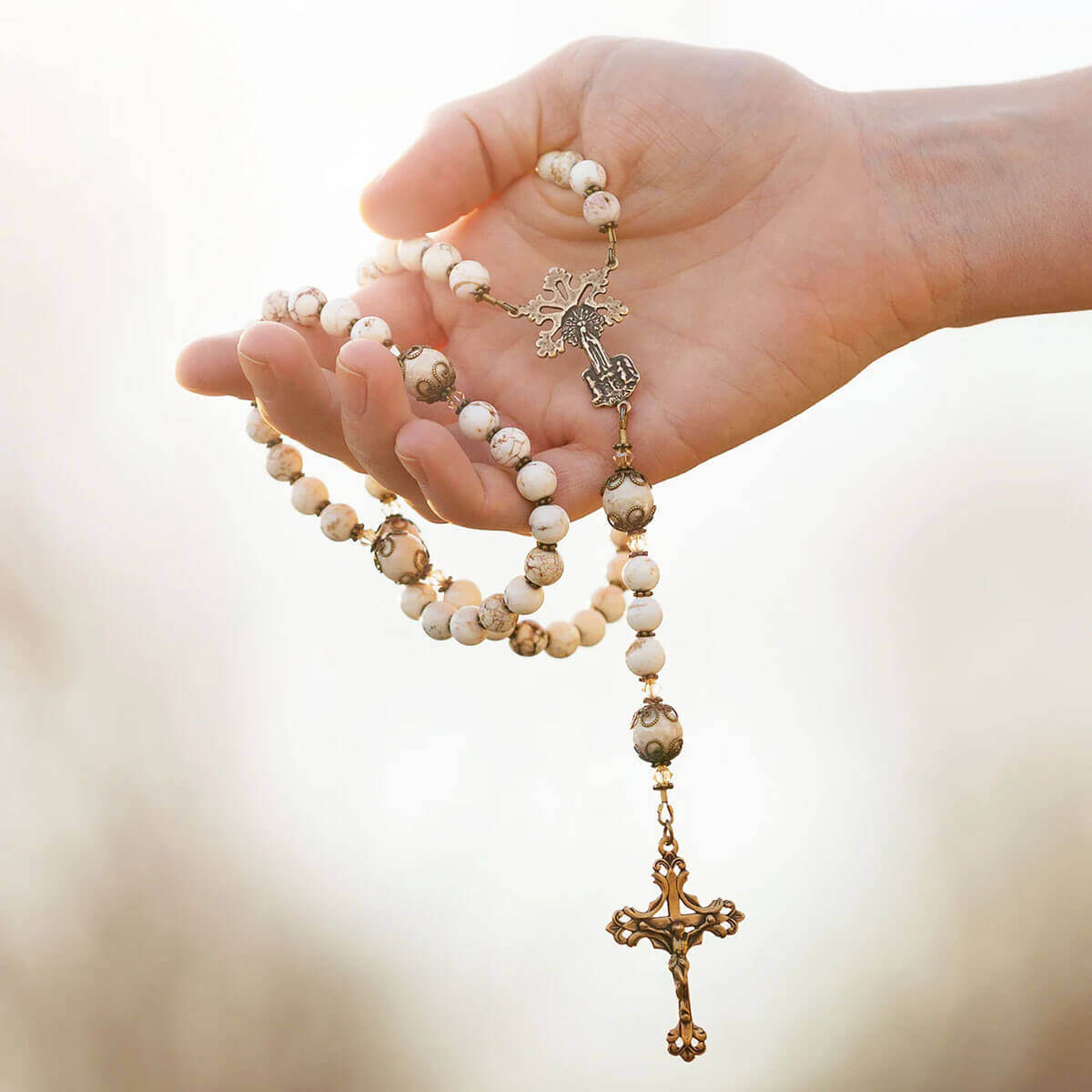August 21st is the anniversary of the Blessed Virgin Mary's apparition at a small village church in Knock, Ireland, in 1879. Known as Our Lady of Knock, it is a major Marian apparition approved by the Church and the one dearest to the Irish people.
The date on which Our Lady appeared had deep significance. Thirty-four years earlier, on the very same day, "The Great Hunger" had begun—a horrible time in which the potato crop, a primary source of food for the Irish people, failed. The famine that resulted was catastrophic. The starving people ate their potato seed in order to survive and then had nothing to plant come the following year. (You can read more about the famine and its effects here.)
Our Lady's miraculous appearance was a great consolation to those who suffered through the terrible famines and extreme hardships of that epoch in Ireland's history. Although it was a silent vision—Our Lady of Knock did not speak a single word—the peace and healing she brought was real and lasting.
What are the details of the apparition?
The Story of Knock began on the 21st of August, 1879 when, at approximately 8 o’clock in the evening, fifteen people from the village of Knock in Co. Mayo, witnessed an Apparition of Our Lady, St. Joseph, St. John the Evangelist, a Lamb and cross on an altar at the gable wall of the Parish Church.
The Lamb of God standing on an altar surmounted by a cross is a symbol of the Holy Sacrifice of the Mass and the Holy Eucharist. St. John was standing with a gesture of teaching while holding a book, presumably the Book of the Revelation, in which he described his vision of the heavenly liturgy.
According to an article published by the Knock Shrine:
The witnesses watched the Apparition in the pouring rain for two hours, reciting the Rosary. Although they themselves were saturated not a single drop of rain fell on the gable or vision. There were fifteen official witnesses to the Apparition, most of whom were from the village of Knock and surrounding areas and ranged in age from just 5 years old to 74 years old. Each of the witnesses gave testimonies to a Commission of Enquiry in October 1879. The findings of the Commission were that the testimonies were both trustworthy and satisfactory.
The vision lasted for approximately three hours before fading.

Here is the eyewitness testimony of Patrick Hill:
"I distinctly beheld the Blessed Virgin Mary, life size, standing about two feet or so above the ground clothed in white robes which were fastened at the neck.
Her hands were raised to the height of the shoulders, as if in prayer, with the palms facing one another, but slanting inwards towards the face; the palms were not turned towards the people, but facing each other as I have described; she appeared to be praying; her eyes were turned as I saw towards heaven.
She wore a brilliant crown on her head, and over the forehead where the crown filled the brow, a beautiful rose; the crown appeared brilliant, and of a golden brightness, of a deeper hue, inclined to a mellow yellow, than the striking whiteness of the robes she wore; the upper parts of the crown appeared to be a series of sparkles, or glittering crosses.
[I saw her eyes, the balls, the pupils and the iris of each.]
I noticed her hands especially, and face, her appearance.
The robes came only as far as the ankles; I saw her feet and the ankles; one foot, the right, was slightly in advance of the other.
At times she appeared, and all the figures appeared, to move out and again to go backwards; I saw them move; she did not speak; I went up very near; one old woman went up and embraced the Virgin’s feet., and she found nothing in her arms and hands; they receded, she said, from her."
This unusual apparition occurred against the outer south wall of the parish church, as seen in the photograph below where the people are gathered. Today the church has been extended with a partial-glass ceiling to incorporate this outside wall as an inside wall. Erected against the south wall are statues that resemble the eyewitnesses's descriptions of the vision as closely as possible.
There is something else about the circumstances of the apparition that is important: prior to its occurrence, Archdeacon Cavanagh, the parish priest, announced to the parishioners his plan to say 100 Masses for the Holy Souls in Purgatory whom Our Lady wished to release. The last of these 100 Masses was offered less than a week before the apparition occurred. This is considered deeply significant by many people.
Ten days after the apparition, the first miraculous cure occurred. By 1880, Fr. Cavanagh had recorded over 300 cures. His record of the cures is preserved to this day.
The Knock Shrine website exhibits historic photos, the testimonies of all fifteen eyewitnesses, and the stories of pilgrims who have visited the apparition site.

Knock has become a place of pilgrimage known for bringing healing, peace, and conversion of heart. Here is the testimony of a recent pilgrim to the Knock Shrine:
“This is my first visit to Knock. I came because my 84 year old mother wanted to come so my wife, my sister and I came with her. I was nonplussed at the idea but have been taken completely by surprise by the wondrous peace that engulfs this magical place. This visit has renewed and strengthened my faith. I leave, I hope, a better person.”
Were you already familiar with this Marian apparition?
Have you been to the Shrine of Our Lady of Knock?
Comment below and tell us about your experience.
Read next: Ancient Irish Litany to the Blessed Virgin Mary

This article was updated in 2019. It was originally published in August of 2015. ©The Catholic Company


























